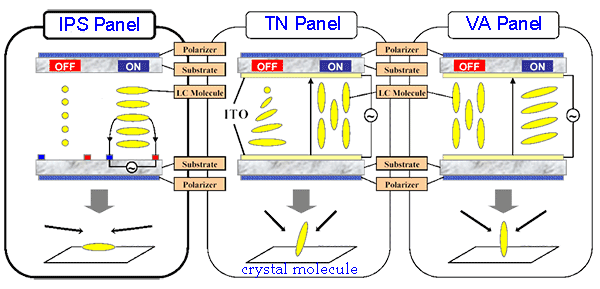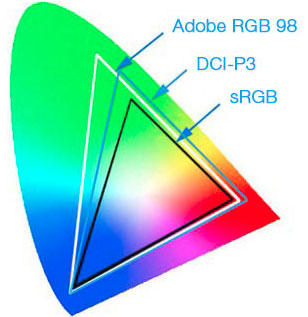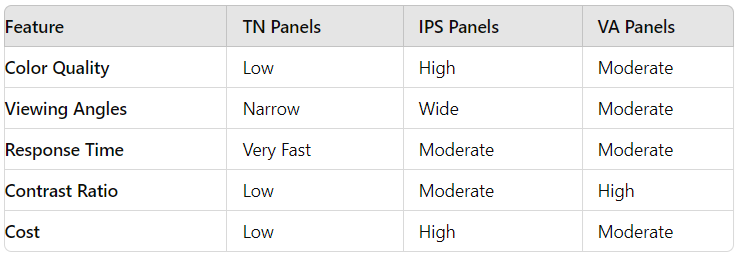Blog
TN Panel vs IPS vs VA Panel
Everyday, we look at LCD display, TV, cell phone, monitor. It becomes a necessity in modern society. LCD panel is the most important part of an LCD display. It determines LCD screen's performance, e.g. brightness, contrast, color and viewing angle. Therefore, picking the right type of LCD panel is critical to your application.?
Types Of LCD Panels
There are three main types of LCD panels in the market, namely TN, IPS and VA.
Twisted Nematic (TN): The oldest type of LCD panel.
In Plane Switching (IPS): It is developed to solve the limitations of TN LCD. Another popular name for IPS panel is "plane to line switching" (LPS).?
Vertical Alignment (VA): Also referred to as “super vertical alignment” (SVA) and “advanced multi-domain vertical alignment” (AMVA). They all?share similar characteristics.
These names reflect the alignment of crystal?molecules inside the LCD, and how they change when they are charged electrically. All liquid crystal displays change the alignment of liquid crystal molecules to work, but the manner in which they do so can drastically affect the image quality and response time.?Each panel type has its advantages and disadvantages. The easiest way to choose between them is to decide which attributes are most important to your project. It mainly depends on what you use your LCD display for, and your budget.
 ?
?
TN Panel
TN is the most mature technology in LCD panel manufacturing. When there is no voltage difference between the two transparent electrodes, liquid crystal molecules are twisted 90 degrees, in combination of upper and bottom polarizers, allows light to pass through LCD. As voltage applied, crystal molecules are untwisted and aligned to the same direction, blocking light.
- Advantages: They have fast response times and are relatively inexpensive to produce.
- Disadvantages: TN panels have poor color reproduction and limited viewing angles.
- Applications: Commonly used in budget monitors, gaming monitors where response time is crucial.
IPS Panel
In IPS panel, crystal molecules?are parallel to the glass substrates at initial stage, LCD is off. When the in-plane electrodes is charged, crystal molecules are rotated, modifying light's direction. Which lights up the LCD display.
- Advantages: IPS technology offers superior color accuracy and wide viewing angles.
- Disadvantages: These panels are generally more expensive and have slower response times compared to TN panels.
- Applications: Widely used in professional monitors, smartphones, and high-end TVs where color accuracy is paramount.
VA Panel
As its name suggests, VA panel's liquid crystals?are aligned vertically without charged. When a voltage is applied, the molecules tilt and modifying light direction.
?
- Advantages: They provide better color reproduction and wider viewing angles than TN panels, with higher contrast ratios.
- Disadvantages: Response times are slower than TN panels but better than IPS panels. They can suffer from color shifting when viewed from extreme angles.
- Applications: Common in TVs and monitors where deeper blacks and better contrast are desired.
So in summary, TN panels twist, IPS panels use a parallel alignment and rotate, while VA panels use a perpendicular alignment and tilt. These difference create LCD display with distinctive performance.
Viewing Angle
IPS LCD is the clear winner in this aspect. It has 178/178 viewing angle?ratings. Which means you can look at IPS LCD display from?any angle without the image shifting in color and contrast. VA LCD has pretty wide viewing angle, too. But it has contrast shifts at off-center angles. As for TN LCD, viewing angle is its weakest point.
Color Quality
Color quality can be split into two areas: color depth (number of colors, usually represented in binary)?and color gamut.?
Most TN LCDs have?6-bits colors. Manufacturers use frame rate control (FRC) to enhance its color performance. For IPS and VA panels, you can still find 6-bits entry level LCD. But most of them are 8-bits. And IPS technology can provide natively 10-bits colors.
 ?
?
Color gamut is another part that VA and IPS panels shine at. The best TN LCD can reach sRGB gamut.?VA panels typically start with full sRGB coverage, and get to around 90% DCI-P3 coverage. With IPS LCD panel, you could find the best ones?full DCI-P3 and Adobe RGB coverage. That is why you see most professional grade LCD displays use IPS panel.
Brightness and Contrast
There is no?inherent differences among the three panel technologies, because LCD backlight is the main factor here. However, there is a big gap in terms of contrast ratio. TN LCD panel tends to have the lowest value among the three. IPS LCD screen sits in the middle?can reach 1500:1. For VA panel, the best one can exceed 4500:1 easily. VA LCD display provides far darker screen than TN & IPS. That is why they are used in vehicle dashboard.?
Refresh Rate
TN panel does have an advantage when it comes to refresh rate. The panel?offers the best refresh rate and response time. This is the reason why?most gaming LCD monitors are made of TN panel.?
Wrap Up
TN LCD provides the best refresh rate and economic solution. If your application requires wide viewing angles and good color presentation, VA panel is probably the choice. While IPS has the best overall visual performance, in general it is more expensive than the other two.?
 ?
?
Topway has more than 20 years experience in manufacturing LCD display. Let us help you choosing the right LCD panel for your project.
